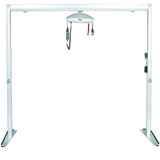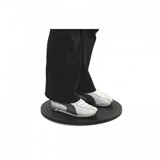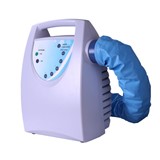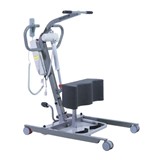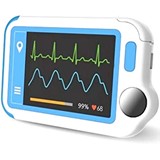Patient hoists are indispensable tools in healthcare settings, facilitating the smooth and secure transfer of patients with limited mobility. To ensure the optimal performance of these vital devices and prioritize the safety of patients and caregivers alike, a robust maintenance and safety approach is paramount. This guide offers essential insights and expert recommendations to help healthcare professionals and caregivers implement effective patient hoist maintenance and safety practices. By adhering to these guidelines, healthcare facilities can enhance the longevity of their hoists and create a safer environment for everyone involved.
I. Importance of Patient Hoist Maintenance and Safety
Patient hoists play a crucial role in healthcare settings, enabling the safe and efficient transfer of patients with mobility challenges. Proper maintenance and adherence to safety protocols are essential to ensure the hoists' optimal performance and safeguard the well-being of both patients and caregivers.
II. Developing a Regular Maintenance Schedule for Patient Hoists
A. Understanding the Significance of Regular Maintenance
Regular maintenance is crucial for ensuring the optimal performance and longevity of patient hoists. Proper maintenance minimizes the risk of malfunctions and breakdowns during critical patient transfers.It enhances the safety of both patients and caregivers, reducing the likelihood of accidents or injuries. Routine maintenance contributes to cost-effectiveness by preventing major repairs and premature replacements.
B. Creating a Maintenance Schedule Based on Manufacturer Guidelines
Consult the manufacturer's user manual and guidelines for recommended maintenance intervals. Identify the specific maintenance tasks to be performed at regular intervals. Take into account the hoist's usage frequency, load capacity, and environmental conditions when scheduling maintenance.Create a detailed calendar or digital reminder system to ensure timely execution of maintenance tasks.
C. Inspection and Calibration of Hoist Components
Regularly inspect all components of the patient hoist, including slings, chains, hooks, and mechanical parts. Look for signs of wear, damage, or corrosion that may affect the hoist's performance. Perform calibration checks on electronic components and sensors to maintain accurate readings.Ensure that safety features, such as emergency stop buttons and overload protection, are fully functional.
D. Record-Keeping for Maintenance History
Maintain a comprehensive record of all maintenance activities performed on each patient hoist. Include details such as the date of maintenance, specific tasks carried out, and any parts replaced. Record observations made during inspections and calibration procedures.
Keep track of any issues identified and the corresponding actions taken to address them.
III. Cleaning and Disinfection Procedures for Hygienic Hoist Usage
A. Importance of Hygiene in Healthcare Settings:
Maintaining high levels of hygiene in healthcare settings is crucial to prevent the spread of infections and ensure patient safety. Patient hoists are essential medical devices used to lift and transfer patients, and they come into direct contact with individuals, making proper hygiene protocols vital.
Contaminated hoists can serve as potential sources of infection transmission, especially in hospitals and care facilities where patients with weakened immune systems are present. By adhering to rigorous cleaning and disinfection procedures, healthcare providers can significantly reduce the risk of healthcare-associated infections (HAIs).
B. Cleaning Frequency and Recommended Cleaning Agents:
Establishing a regular cleaning schedule is fundamental to maintaining a hygienic environment for patient hoists. The cleaning frequency should be determined based on the intensity of hoist usage and the nature of patients being lifted (e.g., frequency of incontinent patients or those with contagious conditions). It is essential to follow the manufacturer's guidelines and recommendations for cleaning and maintenance to ensure the hoist's longevity and optimal performance. Recommended cleaning agents should be non-toxic, effective against pathogens, and safe for use on the hoist's materials, such as metal and fabric components.
C. Proper Disinfection Methods for Patient Hoists:
Disinfection goes beyond simple cleaning and involves the elimination of disease-causing microorganisms from the hoist's surfaces. Before initiating the disinfection process, ensure that all visible dirt and debris are removed through thorough cleaning. Disinfection can be achieved through chemical or non-chemical methods, and the choice of method should align with the hoist's materials and the manufacturer's recommendations. Chemical disinfectants should be used according to their instructions, considering factors like contact time, concentration, and proper ventilation during application.
D. Disposal of Contaminated Materials:
During the cleaning and disinfection process, it is common to generate waste materials, such as cleaning cloths and wipes, that may be contaminated with potentially harmful microorganisms. These waste materials must be disposed of properly to prevent cross-contamination and ensure the safety of healthcare staff and patients. Follow institutional protocols for the safe disposal of contaminated materials, which may involve using biohazard bags or containers. Healthcare facilities must comply with local regulations regarding the disposal of medical waste to mitigate any environmental impact and adhere to best practices.
IV. Inspecting and Lubricating Hoist Components (Slings, Chains, etc.)
A. The Role of Inspections in Ensuring Hoist Performance:
Regular inspections are critical to maintaining the optimal performance of patient hoists. By conducting systematic evaluations, potential issues can be identified and addressed promptly, ensuring the safety and functionality of the equipment.Inspections help to detect early signs of wear and tear, damage, or misalignments in various hoist components. Identifying these issues early on can prevent costly breakdowns and accidents, enhancing the overall reliability of the hoist.
B. Identifying Signs of Wear and Tear:
Visual inspection plays a key role in identifying signs of wear and tear. Hoist operators should be trained to look for any visible damage, deformation, or fraying in the slings, chains, and other components.
Unusual sounds or vibrations during hoist operation might also indicate potential problems. These observations should not be ignored and must be reported for further evaluation and maintenance.
C. Lubrication Guidelines for Smooth Hoist Operation:
Proper lubrication is essential to ensure smooth and efficient hoist operation. It minimizes friction between moving parts, reducing wear and extending the lifespan of the components.
Refer to the manufacturer's guidelines for the recommended type and frequency of lubrication. Different hoist models may have specific requirements, so it is vital to adhere to the manufacturer's instructions.
D. Replacing Worn Components and Sling Inspection:
If during inspections, any components are found to be significantly worn or damaged, they must be promptly replaced with genuine and compatible parts. Using non-standard or incorrect components can compromise hoist performance and pose safety risks.
Sling inspection is a crucial aspect of hoist maintenance. Check for signs of fraying, cuts, or damage to the slings. Any sling found to be defective should be taken out of service immediately and replaced with a new one.
V. Implementing Safety Protocols for Safe Patient Transfers and Lifting
A. Importance of Safe Patient Handling
Safe patient handling is crucial to prevent injuries to both patients and healthcare providers during transfers and lifting procedures. Improper handling can lead to musculoskeletal disorders for caregivers and discomfort or trauma for patients.
Implementing safety protocols ensures a secure and controlled transfer process, promoting better patient outcomes and caregiver well-being.
B. Using the Correct Lifting Techniques
Proper lifting techniques are fundamental in minimizing the risk of injuries and accidents during patient transfers. Encourage caregivers to use a wide base of support and bend their knees while keeping their back straight during lifting. Advise against lifting from the waist, using jerky movements, or attempting to lift a patient alone without assistance.
C. Assessing Patient Readiness for Transfer
Before any transfer, it is essential to assess the patient's physical condition and mental awareness to determine their readiness. Evaluate the patient's weight-bearing capacity and level of cooperation for a safe and successful transfer. Consider the patient's medical condition, recent surgical procedures, or any other factors that might affect the transfer process.
D. Utilizing Transfer and Lifting Aids Correctly
The use of appropriate transfer and lifting aids can significantly enhance safety during patient transfers. Train caregivers on the correct operation and adjustment of hoists, slings, transfer belts, or other assistive devices. Regularly inspect and maintain these aids to ensure their functionality and prevent accidents related to equipment failure.
VI. Ensuring Proper Positioning and Comfort of Patients during Lifting
A. Understanding the Risks of Incorrect Positioning
Improper positioning can lead to discomfort, pressure sores, and injuries during patient lifting. Misalignment of the hoist slings or supports can cause discomfort and compromise patient safety. Incorrect positioning may also lead to musculoskeletal issues for the caregivers involved in the lifting process.
B. Assessing Patient's Comfort and Safety
Before lifting, evaluate the patient's physical condition and any specific medical considerations. Take note of the patient's weight, mobility, and any physical limitations that may affect the lifting process. Communicate with the patient to understand their comfort level and address any concerns they may have.
C. Importance of Communication during Lifting Procedures
Effective communication between caregivers involved in the lifting process is essential.
Ensure that everyone is aware of their roles and responsibilities during the lift.
Establish clear verbal cues or signals to coordinate movements and prevent accidents.
D. Adjusting Hoist Settings for Optimal Patient Support
Each patient may have unique requirements, so adjust the hoist settings accordingly.
Ensure the hoist's lifting capacity is appropriate for the patient's weight to avoid overloading.
Adjust the height and angle of the hoist to achieve proper positioning and support during the lift.
Remember, maintaining proper positioning and comfort during patient lifting is crucial for both patient safety and caregiver well-being.
VII. Staff Training for Correct Hoist Operation and Safe Patient Handling
A. Comprehensive Training for Hoist Operators:
Hoist operator training is a critical component of ensuring safe and efficient patient handling. Operators must undergo comprehensive training to understand the proper operation and maintenance of patient hoists. Training sessions should be conducted by qualified instructors who have expertise in patient handling and hoist operation. Topics covered during training should include safety protocols, risk assessment, proper patient positioning, and the use of different hoist accessories such as slings and harnesses. Operators should also be educated about the importance of communication with patients during transfers and how to address patients' specific needs.
B. Understanding Hoist Controls and Features:
A thorough understanding of hoist controls and features is essential for operators to operate the equipment safely and efficiently. Training sessions should focus on explaining each control and its function, including emergency stop buttons and lifting/lowering mechanisms. Operators should be taught how to adjust the hoist's speed and how to handle situations that require precision movements during patient transfers. Familiarity with additional features, such as powered positioning and scale integration, should also be covered to optimize hoist usability.
C. Practicing Emergency Procedures:
Preparedness for emergencies is crucial when using patient hoists, as unforeseen situations can arise during patient transfers. Training sessions should include simulated emergency scenarios, allowing operators to practice their response and actions in a controlled environment. Emphasis should be placed on quick and effective decision-making, ensuring the safety and well-being of both the patient and the operator. Additionally, operators should be instructed on how to properly handle situations where the hoist malfunctions or encounters power failure.
D. Periodic Refresher Training and Skill Assessment:
To maintain the highest level of competence, hoist operators should participate in periodic refresher training sessions. Refresher courses help reinforce essential skills and knowledge, and they also provide an opportunity to update operators on any changes in safety regulations or hoist operation procedures. Skill assessments during refresher training help identify areas that may need improvement and allow for targeted training to address specific challenges .Records of refresher training and skill assessments should be maintained to demonstrate compliance with safety standards and regulations.
VIII. Adhering to Safety Standards and Regulations for Patient Hoists
A. Overview of Relevant Safety Standards:
Patient hoists are subject to specific safety standards and guidelines established by regulatory bodies and industry organizations. This section provides an overview of the most relevant safety standards that apply to patient hoists, ensuring that operators and healthcare facilities understand and adhere to these requirements.
B. Compliance with Healthcare Regulations:
Healthcare facilities must comply with local and national regulations concerning the use of patient hoists. The section outlines the importance of compliance and the potential consequences of non-compliance, such as legal liabilities and compromised patient safety.
It is crucial to designate personnel responsible for overseeing compliance and conducting regular audits to assess adherence to regulations.
C. Regular Auditing and Certification Requirements:
Regular auditing of patient hoist equipment and safety procedures is vital to maintain a safe environment for patients and operators. This part explains the auditing process, including what aspects are assessed and how often audits should occur. Certification requirements for patient hoists should also be detailed to ensure that healthcare facilities obtain and maintain the necessary certifications to operate their hoists lawfully.
D. Addressing Safety Concerns and Reporting Incidents:
Encouraging a culture of safety involves prompt reporting and addressing safety concerns related to patient hoists. This section outlines the procedure for reporting incidents and safety issues, ensuring that proper investigations are conducted, and necessary actions are taken to prevent future occurrences.
In conclusion, the meticulous maintenance and unwavering commitment to safety for patient hoists are fundamental in upholding the welfare of patients and caregivers alike. By adhering to rigorous maintenance schedules, implementing robust cleaning and disinfection procedures, and prioritizing safe patient handling techniques, healthcare facilities create an environment where optimal hoist performance and patient safety are paramount. Collaborating closely with equipment manufacturers, adhering to safety standards, and fostering a culture of continuous improvement further ensure the seamless functioning of patient hoists. Ultimately, the collective efforts of healthcare professionals, caregivers, regulatory bodies, and manufacturers serve as the cornerstone for elevating patient care and promoting a secure and comfortable transfer experience for all parties involved.




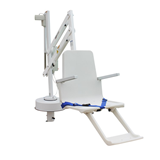
-160x160-state_article-rel-cat.png)

